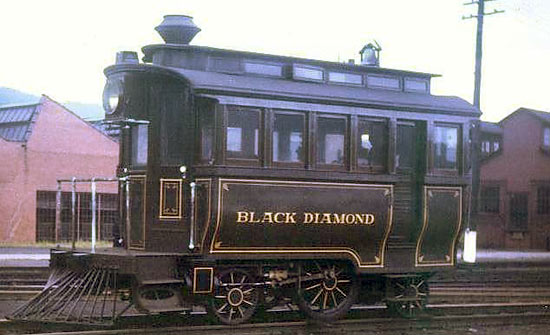2-2-2T Inspection Engine “Black Diamond”

Outside Reading, PA Shops, 1947. (Photographer unknown)
Background & History
The Inspection Engines were as much an oddity in the early days of the railroads as they were later on, and still are so regarded by railroad buffs and historians studying motive power history. The combination of a passenger coach body on a steam engine chassis was not exclusive of the Philadelphia & Reading Railroad Co., but the P&R may well lay claim to being one of the few railroads that built and operated them, having no less than twelve throughout its history. They were utilized by company officers, managers and road foreman to inspect road work and construction projects, as well as acting as a paymaster’s office for paying track building and repair crews right on the job. They certainly bore a remarkable similarity to the early self-powered horseless carriages that later became the trolley cars of all the large cities and towns.*[1]
“Black Diamond” was built in 1889 by the Baldwin Locomotive Works. Completely restored by Reading Loco Shops mid 30’s. Sold to Vernon Piper in 1949. Loaned? to the National Museum of Transportation in St. Louis, MO. Oldest surviving P&R inspection engine.
Archival Photos
• Photos to come.
| “Black Diamond” Specifications (as-built): *[2] | |||
|---|---|---|---|
| Builder: | Baldwin Locomotive Works, Philadelphia, PA | Cylinders (2): | 8.25" dia. x 8.5" stroke |
| Date built: | May 1889 | Cylinder horsepower: | unknown |
| Wheels: | 2-2-2T | Boiler pressure: | 160 p.s.i. max. |
| Length: | 22' 9" | Tractive effort engine: | 1,871 lbs. |
| Driving wheel diameter: | 42" | Tractive effort w/Booster: | n/a |
| Weight on drivers: | 26,350 lbs. | Horsepower rating: | unknown |
| Total engine weight: | unknown | Top speed: | unknown |
| Total weight in working order: | unknown | Tender capacity: | unknown |
| Grate area: | unknown | Fuel: | Coal |
| Notes: | |
|---|---|
| *1 (info courtesy Steam Locomotives of the Reading and P&R Railroads by Edward Wiswesser) *2 (info courtesy steamlocomotive.info) |
(last updated: 6/03) |